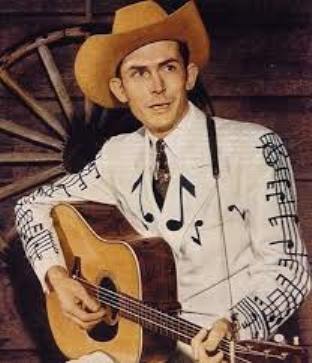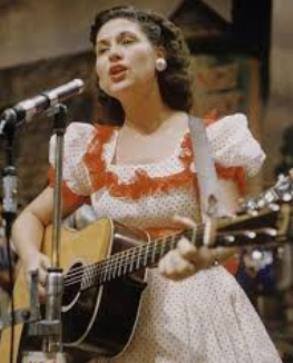|
This was the summer of 1954, and Hank Williams had been dead for a year and a half – dying in a moving car in a snowstorm in West Virginia on New Year’s Eve. But we didn’t necessarily know that. We just knew he was a voice, a plaintive voice, on the jukebox.
The diner was in a hamlet called North Creek in upstate New York. I was staying a month with people who were (are) like family to me. Many evenings after supper, Jimmy, who was six days younger than me (that’s how our mothers met) and I would hitch-hike the 7.7 miles to the Red Diner. We were 15. The diner had a corner with, as I recall, a pinball machine, and guys could drink a beer and play the jukebox. I was a city kid – no doubt made that point way too often – and my main connection with “country” or “western” or “hillbilly” music was from Gene Autry records and seeing him in the rodeo in Madison Square Garden. Hank Williams was no Gene Autry. He was a phenomenon unto himself – wailing and courting, letting it all out, six plays for a quarter, as I recall. “Hey, Good Lookin’,” “Jambalaya,” “Cold, Cold Heart,” “Your Cheatin’ Heart.” It was an education for this city kid, and the education goes on, in the PBS series that is pulling me to the tube, two hours every night, all this week. It is about America – hard times, nasty times, lynchings and injustices but also the contribution of African-Americans to the swath of American music. I learn something every minute – the old icons I saw at the Ryman in the 70’s and 80’s, long after they were young and hungry and immensely creative. I heard them first on the jukebox in the Red Diner in North Creek – Webb Pierce, Hank Thompson, Eddie Arnold, Pee Wee King (later my Louisville neighbor), Hank Snow, Ernest Tubb. There was also a woman’s voice, as piercing as Hank Williams’, cutting into the noise in the Red Diner. Her song was a reply to Hank Thompson’s “Wild Side of Life,” which blames women for leading us poor men astray. Miss Kitty Wells was having none of it. She, too, borrowed an old Carter Family tune, and she lectured the men: “It Wasn’t God Who Made Honky-Tonk Angels.” In the smoky, noisy corner of the Red Diner, we were getting a dose of feminism, although we hardly knew that. Her song had been banned on some chicken networks, fearful of offending (male) listeners and (male) sponsors, but I never heard any of the farmhands in their clean boots and jeans, or the townies, or teen-agers like me, debate Miss Kitty’s point. Lady had a point. After our hour or two in the Red Diner, we got out into the cool night air, crossed the street into the woods to pee into the Hudson River and then point our thumbs homeward. The PBS series makes me think about the jukebox in the Red Diner. As of Tuesday, the series was up to 1953. No Patsy Cline, no Loretta Lynn, no Dolly Parton, no Emmylou Harris, no Lucinda Williams, no Iris DeMent. Not yet. Kitty Wells passed in 2012, at the age of 91. She was there first. * * * Bio of Kitty Wells: https://americansongwriter.com/2019/03/kitty-wells-it-wasnt-god-who-made-honky-tonk-angels/ 9/18/2019 05:55:27 pm
George—I’m a few taped shows behind you do to other commitments, but I’m looking forward to seeing them all.
George Vecsey
9/19/2019 10:11:33 am
Alan, I'm sure you read the obit of John Cohen of the New Lost City Ramblers. 9/19/2019 10:43:24 am
George-It is hard to pick a favorite when so many would qualify. However, the Lost City Rambles were very high on my list. John Cohen, Mike Seeger and Tracy Schwarz had an authentic sound. 9/19/2019 09:15:41 am
Great thoughts, memories and observations, George (and Alan!). I haven't heard North Creek, NY mentioned in decades. I camped out there many years ago. Beautiful country.
GEorge
9/19/2019 10:17:51 am
Peter, thank you. I haven't been back to North Creek in a decade or two, but the Red Diner was nowhere to be seen. Now that we have family upstate, I plan an expedition to the area just above North Creek. I am told the place hasn't changed -- lovely little lake, walking distance from our old friends, where they had community picnics one Sunday in August, when my friends and I were put in charge of guarding the beer overnight (!) and we listened to WWVA, straight from Wheeling.
Altenir Silva
9/19/2019 05:01:53 pm
Dear George,
George Vecsey
9/21/2019 11:45:05 am
Dear Altenir: My guess is that the series will be available on CD after it runs -- also, through the mysteries of the web, catalogued and available directly from Lisbon. I'll keep an eye out for you.
Altenir Silva
9/21/2019 02:01:11 pm
Dear George,
Randolph
9/19/2019 09:15:50 pm
George,
Randolph
9/22/2019 09:03:25 pm
George, Comments are closed.
|
Categories
All
|











